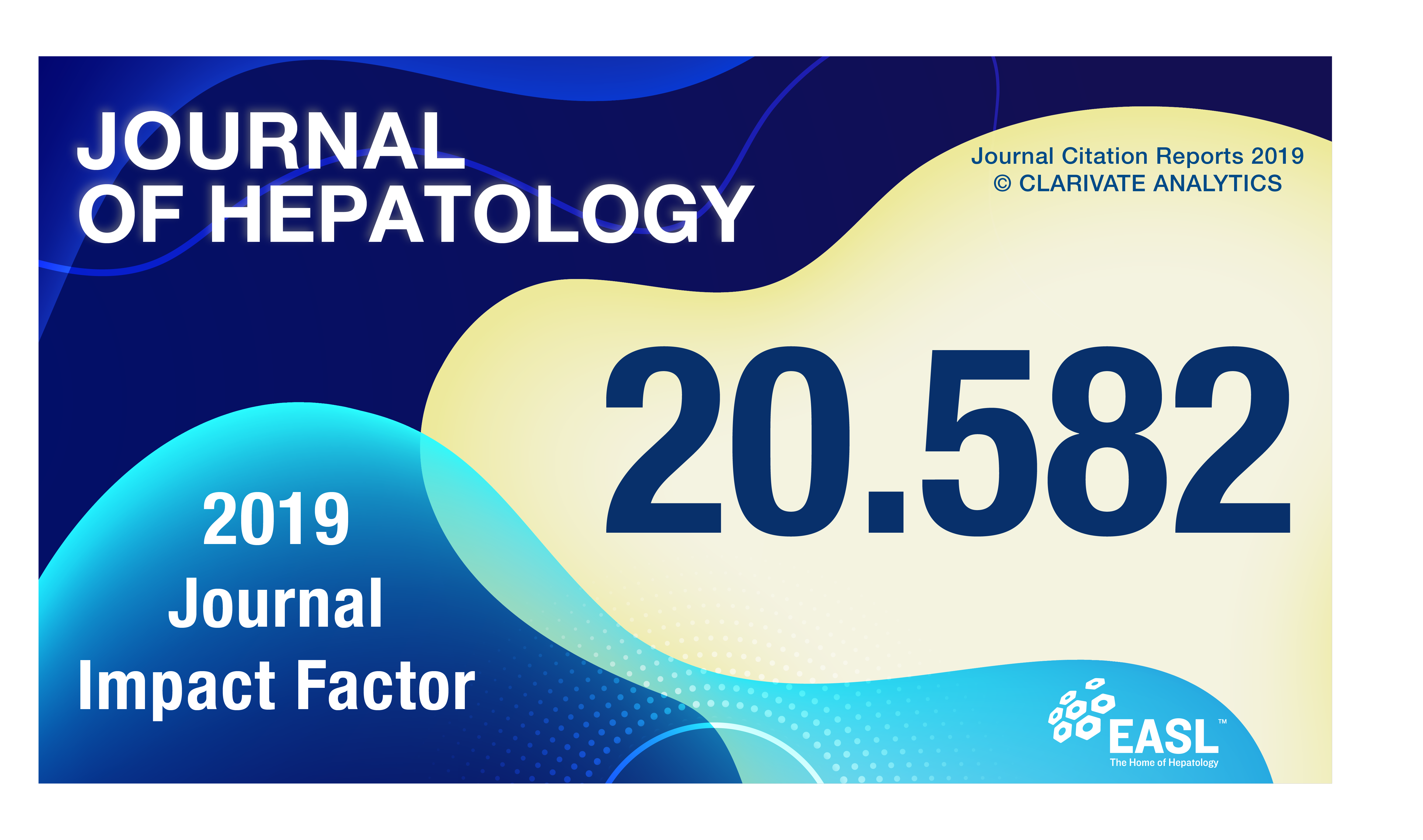Journal of Hepatology ranking climbs, remaining best journal on liver disease

ClarivateTM Analytics released the 2020 update of its Journal Citation Reports©, including the much anticipated 2019 impact factor. EASL’s flagship monthly journal, the Journal of Hepatology, achieved unprecedented results with a 2019 impact factor of 20.582, up from the 2018 score of 18.946.
Geneva, Switzerland, 1 July 2020 – The ranking reveals that the Journal of Hepatology continues to surge ahead with an impressive 9% increase in one year and a total increase of almost 100% in the past four years. To date, the 2019 score is the highest the Journal of Hepatology has achieved.
The EASL Governing Board congratulates the editorial team, its board, and the Journal office on their amazing achievement in delivering the highest ever impact factor for the Journal of Hepatology. The ever-increasing innovation in the journal means it now attracts some of the most important papers in the literature, which have a major impact on research and clinical practice. The Journal of Hepatology is at the heart of what EASL does best, and thanks to the hard work of Paolo Angeli and his team, and the editors-in-chiefs and editorial boards in years before, it has become a truly established top-tier journal,” said Prof. Phil Newsome, Secretary General of EASL.
“The continuous increase of the Journal’s impact factor over recent years, together with similar increases of other metrics prove once again that we are providing the scientific community with high-quality articles in the field of hepatology. Let me say that it is very impressive to see that the Journal of Hepatology has now attained the first position, not only among the specialist hepatology journals, but also in the wider field of gastroenterology and hepatology. In the light of this great result, I feel strongly the duty and pleasure to thank all of those who contributed and who are still contributing to this incredible work: the EASL Governing Board, the senior editors, the associate editors and the reviewers. Moreover, I would like to express my special thanks to the members of the Editorial Office who deserve full recognition for their great dedication to a task that is sometimes challenging, especially in these times. Our aim for the future is to further improve the service we offer to the community, to raise even higher the bar of the quality of research that we publish, with a more widespread reach and interaction with all the members of our community: scientists, physicians, patients, caregivers, and decision-makers in healthcare. We have received this commitment from EASL, the Home of Hepatology™, and we will endeavour to perform this to the best of our ability,” said Prof. Paolo Angeli, Editor-in-Chief of the Journal of Hepatology.
The record high score, together with similar increases in other metrics, reaffirms the continued commitment of EASL, to provide the scientific community with a high-quality publication that delivers impactful content in liver research.
An impact factor is a measure of a journal’s significance in an academic field. It considers the frequency with which the average article in a journal is cited in a given year. This data helps indicate a journal’s relative importance when compared to other publications in the same field. The Journal of Hepatology publishes 12 issues a year and covers a wide variety of topics in clinical and basic research within the field.
About the Journal of Hepatology
The Journal of Hepatology is the official journal of the European Association for the Study of the Liver (EASL). It publishes original papers, reviews, case reports, and letters to the Editor concerned with clinical and basic research in the field of hepatology. It is a monthly, English language, peer-reviewed journal. First published in 1985 as the official journal of EASL, it provides an international forum for the publication of original articles, reviews and letters to the Editor describing basic laboratory, translational, and clinical investigations in hepatology. All articles undergo a rigorous peer review and are selected based on the originality of the findings, the superior quality of the work described, and the clarity of presentation. http://www.journal-of-hepatology.eu
This year, the Journal of Hepatology achieved exceptional results with a 2018 impact factor of 18.95, the highest the Journal has achieved, and with more than 2,600,000 downloads in 2018, it is firmly established as one of the premier publications in the field of gastroenterology and hepatology. Last year 46% of submissions originated from Asia, 13% from the USA, and 33% from Europe, indicating the truly international nature of the Journal.
About The European Association for the Study of the Liver (EASL) – The Home of Hepatology
In the fifty plus years since EASL was founded, it has grown from a small organisation that played host to 70 participants at its first meeting, to becoming the leading liver association in Europe. EASL attracts the foremost hepatology experts as members and has an impressive track record in promoting research in liver disease, supporting wider education, and promoting changes in European liver policy.
Clarivate Analytics
Clarivate™ Analytics accelerates the pace of innovation by providing trusted insights and analytics to customers around the world, enabling them to discover, protect and commercialize new ideas faster. Formerly the Intellectual Property and Science business of Thomson Reuters, it owns and operates a collection of leading subscription-based businesses focused on scientific and academic research, patent analytics and regulatory standards, pharmaceutical and biotech intelligence, trademark protection, domain brand protection and intellectual property management. Clarivate™ Analytics is now an independent company with over 4,000 employees, operating in more than 100 countries and owns well-known brands that include Web of Science™, Cortellis™, Derwent™, CompuMark™, MarkMonitor® and Techstreet™, among others. For more information, please visit clarivate.com

